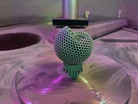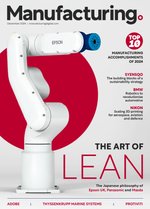Boliden: Additive manufacturing on the rise is ‘exciting’

An increasing number of businesses are diving in to use additive manufacturing.
But the challenge now is not creating the technology behind additive manufacturing, but providing manufacturers with the knowledge of how to use it efficiently.
Additive manufacturing allows manufacturers to quickly create the parts they need, without the use of moulds. Manufacturers use computer-aided-design (CAD) software, which prints precise shapes in layers.
The technology creates less waste than traditional manufacturing and uses less energy. As a result, additive manufacturing is considered to be the more sustainable option.
The huge technological advancement has been made possible due to the transition from analog to digital processes. Other terms such as "3D printing" and also "rapid prototyping" are interchangeably used in reference to additive manufacturing.
Sustainability rules in additive manufacturing
According to the University of Southern Denmark, one third of manufacturing companies used AM technology in 2021.
Thomas Hofman-Bang, CEO of Industriens Fond, believes this is because of the strong emphasis on sustainability in the country.
“Danish companies must be more sustainable than they are today because it is crucial that our industry plays an active role and helps to lift if we, as a society, are to succeed in sustainable change,” said Hofman-Bang. “The results of the analysis show positive development because the Danish business community must prioritise sustainable production and look at new technological solutions such as additive manufacturing, which has a very special sustainable potential”.
Frank Rosengreen Lorenzen, believes that technology is no longer the challenge.
“There are now a vast number of printers and software, and you can print in materials such as concrete, titanium, glass, plastic, chocolate, composite, etc. The big challenge today is that the industry lacks knowledge about how they, as manufacturers, can build a business model around 3D printing, how they can design and develop an AM component or product, and how they can document the environmental benefits,” said Lorenzen. “In the coming years, we must demand of our manufacturers that they dare to free themselves from the – I am tempted to say old-fashioned – production processes on which we have built industrialisation and instead, explore the opportunities and benefits that exist in additive production”.
Additive manufacturing in mining ‘the most exciting thing to happen in the supply chain’
Swedish mining company Sandvik is collaborating with another mining company, Boliden, to trial additive manufacturing in the creation of its machine parts, used on underground drill rigs.
Ronne Hamerslag, Head of Supply Management at Boliden, knows that additive manufacturing shows a lot of potential. It can reduce the carbon footprint within the supply chain through reduced need for transport and storage of parts and also due to shorter delivery times.
“This trial will give us a deeper understanding on how we can move forward and develop our business in a competitive way,” said Hamerslag. “If you ask me, it’s the most exciting thing that’s happening in the supply chain. Its efficiency, speed and climate friendliness mean that we have to investigate Additive Manufacturing closely. We are only at the proof-of-concept stage with Sandvik right now, but it’s already clear that it could become a game-changer for the spare parts business in mining – for both miners and equipment manufacturers.”
Erik Lundén is President of Parts and Services at Sandvik Mining and Rock Solutions. He knows that by 3D printing parts locally, his company is offered the prospect of not only getting parts to the customer much faster, but doing so far more sustainably.
“Mining equipment can last up to twenty-five years – and needs to be supported throughout that time, even in the most remote of locations,” said Lundén. “We have many different SKUs (stock keeping units), and from an inventory point of view we can’t tie up the capital that keeping all these parts in stock would entail.”
- Carbmee: Helping Maersk & Coca-Cola Curtail Carbon EmissionsSustainability & ESG
- Inside Omika Works, Hitachi's Smart Factory SolutionSmart Manufacturing
- EY: How Technology Can Power Green ManufacturingSustainability & ESG
- Thermo Fisher & Novo Nordisk Drive Future of Cell TherapyProduction & Operations


